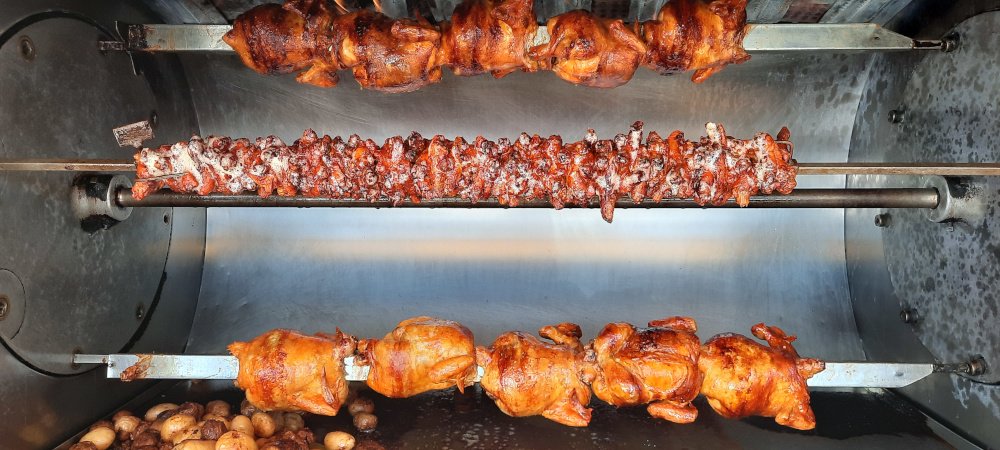How to Maintain a High-Protein Diet in Mexico
The importance of protein in our diets is getting more press than ever recently, with the crowd contending that most of us aren’t getting enough becoming more vocal.
The two key ways of reducing the loss of muscle mass as we age are proper exercise and the right amount of protein, specifically the amino acids found in protein. With strength training and the consumption of high levels of protein, studies indicate we can maintain mass and even grow muscle for most of our lives.
According to Men’s Health, to build a stronger body you need to fulfill a daily protein goal and space it out throughout the day, as our bodies can only absorb around 30 grams at a time. The most conservative estimate for protein needs are .8 grams per pound of body weight. Many experts believe we need between 1.4 - 1.7 grams, especially older and active people.
Planning a high protein diet in Mexico takes deliberation and a good bit of planning. Beef is expensive and often tougher due to how cattle are raised. Mexican beef doesn’t lend itself as well to steak dinners as nicely marbled American beef.
You can’t count on finding a lot of meat in most restaurant meals, nor in street foods. Even the ubiquitous tacos won’t have more than a few tablespoons of carne in them. You’ll need to hunt down your protein just like your ancestors did and prepare most of your own meals if you want to maintain a high quality, high protein diet in Mexico.
Meats
According to the American Journal of American Nutrition, the best muscle-building diet includes meat. Animal protein builds muscle better than soy or vegetable protein. In Mexico, beef tends to be tougher and it’s butchered differently to accommodate popular cooking techniques such as braising. Pork is widely consumed in Mexico, especially ham. Ham purchased in supermarkets in Mexico is always processed so should be avoided. Stick with chops, loins and shoulder cuts.
Grocery stores carry whole refrigerated cases of SuKarne arrachera marinated steaks and shredded meats (I avoid the shredded style beef as it’s smoked). Rather than grilling the steak as usually recommended in recipes, try stewing arrachera steak to tenderness with a diced tomato, onion, a clove of garlic and chopped jalapeño like Mexican home cooks do.
Chicken
Rotisserie chicken pollo asada or pollo rostizado is sold in street front stores for about 140 pesos ($7-8 dollars). Check the city you’re in as there are places that deliver them (like Puro Pollo in Mazatlán, which delivers with fixings for 200 pesos (about $11 dollars).
When purchasing roast chickens, don’t neglect to make a bone broth from the carcass to add a protein boost to your next soup. It’s as easy as dumping the carcass in a pot of water, adding bay leaf and some past-their-prime vegetables, simmering for 4-6 hours and straining. Pasta cooked in fresh broth also tastes amazing.
Grocery store prepared foods
The best meats you’ll find in prepared-food sections of grocery stores are cochinita pebil. Recipes often present it as shredded pork but what I’ve seen in grocery stores in Mexico are chunks of lean pork shoulder bathing in a delicious chile sauce. The beef version is barbacoa de res, lean chunks of roast beef also in a sauce (it’s not barbecue sauce as you know barbecue though). Two dishes that are nothing but meat and sauce. Can’t beat that.
Seafood/Fish
Seafood is plentiful in Mexico, but what you’ll see guys carrying in their Tupperware with them to the gym is tuna. I must warn you that canned tuna in Mexico is disgusting. In spite of Mexico being a prime source of the world’s tuna, its best catches are shipped to Japan and the Far East, where it is bid upon like precious metal. The one good canned tuna is the brand Dolores Premium, increasingly available in grocery stores. They have several types. Buy only the can that sports a clear lid through which you can actually see the tuna.
Non-meat sources of protein
While only animal sources provide complete protein, non-meat proteins easily accessible in Mexico are almonds, peas, soy milk, broccoli, hummus, cottage cheese, black beans, Greek yogurt and lentils. (You can substitute green peas for half the avocado in a guacamole without telling the difference).
Tortillas with beans creates a complete protein, making them the mainstay of the Mexican working man’s diet. Be aware that most pre-prepared refried beans are made with lard (cerdo) so check the label. The black stamp on food packages tells you if the food has high levels of sugar, fat and/or salt.
Protein smoothies
Most rental kitchens have blenders (to accommodate the margaritas factor in most tourist diets). Protein shakes are the fastest, easiest way to bump up your protein intake. The great thing about protein smoothies is they allow you to throw in that over ripe banana, peanut butter and a variety of fruits for more nutritional benefit. A protein shake can add more than 40 grams of protein to your daily intake.
Whey protein powders are better muscle builders than soy and plant proteins. Whey powders are widely available at Walmarts and black iron gyms in Mexico. The latter often sell per serving baggies of whey protein for 20-40 pesos (around two dollars), handy when you only need a few days worth until you can find a store with what you want or are traveling. Protein bar, cookies and chip selection is limited.
Buying unflavored whey powder enables you to add it to other foods (breakfast cereals, soups, yogurt, casseroles). GNC stores (in larger towns) usually carry at least one plant based protein powder option. Organic stores may offer more plant-based options and smaller jars for travel.
Always check the jar in the store before you purchase canisters of protein and make sure it’s not been opened. I once bought creatine and protein powder from a GNC and both jars had been opened. GNC is still a good place to purchase products however because they have good return policies (return policies for anything are pretty uncommon in Mexico).
Eggs
Eggs are a gorgeous source of protein and amino acids. Try them scrambled with nopales cocidos (sold in grocery stores in plastic bags) for a digestive boost and a lighter start at breakfast. No need to buy a dozen if you happen to be staying just a few days in one place. Eggs can be purchased individually in small grocery stores (you may have to ask for them).
Milk
The brand LALA produces milk with a whopping 54 grams of protein (!) that’s available in most grocery stores and OXXO convenience stores. A big glass of this milk in a frosted mug (maybe with a concha) is a great way to start the day.
About the author:
Kerry Baker is an author of three books for the aspiring expat. Her most recent is The Lazy Expat: Healthy Recipes That Translate in Mexico. The only way to maintain a healthy diet in Mexico is to cook. This is a book you will want to take with you every single trip.
The second book, If I Only Had a Place is the complete guide to renting luxuriously and well in Mexico, the secrets that realtors don’t want you to know.
The Mexico Solution: Saving your money, sanity, and quality of life through part-time life in Mexico is the ultimate guide to easing into expat life by living in Mexico part-time first. It’s both a practical guide and a romp through the cultural considerations of life in another country.

